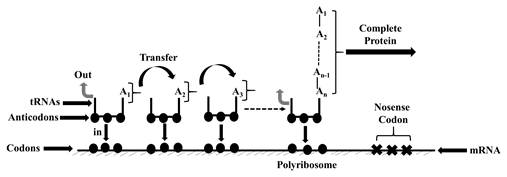
Concept explainers
(a)
Interpretation:
The role of m-RNA in protein synthesis should be explained.
Concept Introduction:
The sequence of the amino acids in the protein is determined by the sequence of bases in DNA, and the relationship between these two sequences is called the genetic code.
The DNA molecules which occurs in the chromosomes found in the cell nucleus, usually exists as double helices. RNAs are usually single strands, but one RNA and one DNA can also form a double helix, which is known as hybridisation of RNA and DNA.
In this way a given DNA determines the base sequence in its complementary RNA. When the RNA strand is synthesised, the DNA-RNA double helix splits.
Three types of RNAs are synthesised in this way, each performing one type of function in protein biosynthesis. One RNA acts as messenger or informational RNA; this is mRNA. The second type of RNA is the transfer RNA, tRNA and the third type of RNA is the ribosomal RNA i.e. rRNA. The base composition of different mRNAs and different tRNAs vary, rRNAs show little bit variation. The variations are possible because RNA molecules are very much smaller than the DNA molecules and so several RNAs can be synthesised from a DNA, each RNA being synthesised on a specified part of DNA molecule. The process of protein synthesis can be shown by a single diagram as-

(b)
Interpretation:
The role of t-RNA in protein synthesis should beexplained.
Concept Introduction:
The sequence of the amino acids in the protein is determined by the sequence of bases in DNA, and the relationship between these two sequences is called the genetic code.
The DNA molecules which occurs in the chromosomes found in the cell nucleus, usually exists as double helices. RNAs are usually single strands, but one RNA and one DNA can also form a double helix, which is known as hybridisation of RNA and DNA.
In this way a given DNA determines the base sequence in its complementary RNA. When the RNA strand is synthesised, the DNA-RNA double helix splits. Three types of RNAs are synthesised in this way, each performing one type of function in protein biosynthesis. One RNA acts as messenger or informational RNA; this is mRNA. The second type of RNA is the transfer RNA, tRNA and the third type of RNA is the ribosomal RNA i.e. rRNA. The base composition of different mRNAs and different tRNAs vary, rRNAs show little bit variation. The variations are possible because RNA molecules are very much smaller than the DNA molecules and so several RNAs can be synthesised from a DNA, each RNA being synthesised on a specified part of DNA molecule.
Want to see the full answer?
Check out a sample textbook solution
Chapter 16 Solutions
EBK CHEMISTRY FOR CHANGING TIMES
- Steps and explanations pleasearrow_forwardUse diagram to answer the following: 1.Is the overall rxn endo- or exothermic. Explain briefly your answer____________________2. How many steps in this mechanism?_____________3. Which is the rate determining step? Explain briefly your answer____________________4. Identify (circle and label) the reactants,the products and intermediate (Is a Cation, Anion, or a Radical?) Please explain and provide full understanding.arrow_forwardDraw the entire mechanism and add Curved Arrows to show clearly how electrons areredistributed in the process. Please explain and provide steps clearly.arrow_forward
- Match the denticity to the ligand. Water monodentate ✓ C₂O2 bidentate H₂NCH₂NHCH2NH2 bidentate x EDTA hexadentate Question 12 Partially correct Mark 2 out of 2 Flag question Provide the required information for the coordination compound shown below: Na NC-Ag-CN] Number of ligands: 20 Coordination number: 2✔ Geometry: linear Oxidation state of transition metal ion: +3 x in 12 correct out of 2 question Provide the required information for the coordination compound shown below. Na NC-Ag-CN] Number of ligands: 20 Coordination number: 2 Geometry: linear 0 Oxidation state of transition metal ion: +3Xarrow_forwardCan you explain step by step behind what the synthetic strategy would be?arrow_forwardPlease explain step by step in detail the reasoning behind this problem/approach/and answer. thank you!arrow_forward
- 2. Predict the product(s) that forms and explain why it forms. Assume that any necessary catalytic acid is present. .OH HO H₂N OHarrow_forwardconsider the rate of the reaction below to be r. Whats the rate after each reaction? Br + NaCN CN + NaBr a. Double the concentration of alkyl bromide b. Halve the concentration of the electrophile & triple concentration of cyanide c. Halve the concentration of alkyl chloridearrow_forwardPredict the organic reactant that is involved in the reaction below, and draw the skeletal ("line") structures of the missing organic reactant. Please include all steps & drawings & explanations.arrow_forward
 ChemistryChemistryISBN:9781305957404Author:Steven S. Zumdahl, Susan A. Zumdahl, Donald J. DeCostePublisher:Cengage Learning
ChemistryChemistryISBN:9781305957404Author:Steven S. Zumdahl, Susan A. Zumdahl, Donald J. DeCostePublisher:Cengage Learning ChemistryChemistryISBN:9781259911156Author:Raymond Chang Dr., Jason Overby ProfessorPublisher:McGraw-Hill Education
ChemistryChemistryISBN:9781259911156Author:Raymond Chang Dr., Jason Overby ProfessorPublisher:McGraw-Hill Education Principles of Instrumental AnalysisChemistryISBN:9781305577213Author:Douglas A. Skoog, F. James Holler, Stanley R. CrouchPublisher:Cengage Learning
Principles of Instrumental AnalysisChemistryISBN:9781305577213Author:Douglas A. Skoog, F. James Holler, Stanley R. CrouchPublisher:Cengage Learning Organic ChemistryChemistryISBN:9780078021558Author:Janice Gorzynski Smith Dr.Publisher:McGraw-Hill Education
Organic ChemistryChemistryISBN:9780078021558Author:Janice Gorzynski Smith Dr.Publisher:McGraw-Hill Education Chemistry: Principles and ReactionsChemistryISBN:9781305079373Author:William L. Masterton, Cecile N. HurleyPublisher:Cengage Learning
Chemistry: Principles and ReactionsChemistryISBN:9781305079373Author:William L. Masterton, Cecile N. HurleyPublisher:Cengage Learning Elementary Principles of Chemical Processes, Bind...ChemistryISBN:9781118431221Author:Richard M. Felder, Ronald W. Rousseau, Lisa G. BullardPublisher:WILEY
Elementary Principles of Chemical Processes, Bind...ChemistryISBN:9781118431221Author:Richard M. Felder, Ronald W. Rousseau, Lisa G. BullardPublisher:WILEY





